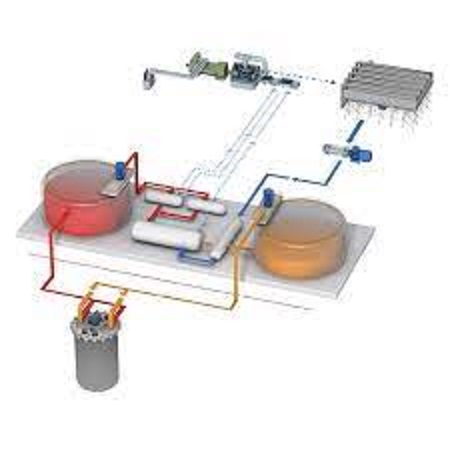SMR: a young, but growing technology, despite NuScale

Late last year, US energy company NuScale announced it would pull the plug on a small modular reactor ( SMR ) project in the western state of Idaho.
The project – the only SMR project yet to be approved by the US Nuclear Regulatory Commission – faced a cost escalation that took the estimated price tag from $5.3 billion to $9.3 billion . An excessive amount for a “Small” reactor project.
The “failure of NuScale's design should spell the end of small modular nuclear reactors,” predicted MV Ramana, a professor at the University of British Columbia.
But according to S&P Global Commodity Insights analyst Mason Lester, there are “a lot of good things that have come in the last year” for the U.S. nuclear outlook.
He explained that the new focal point in SMR development will be Darlington in Ontario, Canada, where GE Hitachi aims to have its new SMR design, the BWRX-300, start producing power in 2029.
“Pending regulatory approval, nuclear construction work will begin in 2025,” Ontario Power Generation told AFP.
The Tennessee Valley Authority, a federally owned U.S. electric utility covering several southern states, also invested in the BWRX-300.
“At the end of the day, it was a single project,” John Kotek of the Nuclear Energy Institute, an industry group, said of NuScale's venture in Idaho.
NuScale's problems are those of a young industry
The problems that led to the failure of the Nuscale project in Idaho are linked to a series of factors that were obvious on the one hand and unexpected on the other.
First of all, there are factors not directly linked to the nuclear sector, such as the increase in costs of steel and raw materials in general. So Uranium has also seen an increase in its cost.
Then there were the foreseeable problems with the new nuclear reactors, namely those linked to the design costs and to the fact that the first modular reactor was a prototype, onto which the industrialization and design costs of the entire series of SMRs were downloaded.
An SMR, especially one made with traditional technologies, has meaning only if built in series and beyond a certain number of specimens. A single SMR, like a single car compared to a mass production, has a much higher cost than the cost when the production chain was started.
Among other things, uranium prices also increased during the period in question
The technology is still to be tested
TerraPower plans to begin construction of a nuclear reactor in June in Kemmerer, Wyoming, at a decommissioned coal plant very soon, having already applied for federal permission to build the reactor.
This is a very different technology from the one used by NuScale because Terrapower plans to use an innovative molten sodium salt reactor, with the use of military-grade highly enriched uranium and it is a fast neutron reactor.
“I could see people saying, 'Here comes nuclear again,' when in reality it's very different,” Burkey said of cost pressures, which are “common to any infrastructure sector.”
“We hope that innovation can help solve this problem,” Burkey said.
TerraPower, which is also working with GE Hitachi and is backed by a group of investors that includes Bill Gates, is focusing on a new "molten chloride" technology that it says can operate at higher temperatures than conventional reactors , allowing for greater efficiency.
Another project under development is that of Ultra Safe Nuclear Corporation , which has chosen Gadsden, Alabama, for its micro-modular reactor (MMR) assembly plant, which is expected to come online in 2027. This plant, to only, it should assemble at least 10 per year. Here is a short illustrative video of the reactor
Europe is behind conceptually and in planning terms
While China and Russia already have operational small reactors, the United States is ahead of Europe in this area of nuclear power, said Sylvain Cognet-Dauphin of S&P Global Insights.
“My impression is that Europe lags behind the United States in SMRs,” Cognet-Dauphin said.
“There are some discussions going on. And there have been some new projects proposed, but nothing as advanced” as projects in the United States, he added. Only EDF is preparing an SMR, but of very traditional technology, the NUWARD , a traditional compressed water reactor, only smaller. An expensive dead end.
In Washington, the U.S. House of Representatives passed legislation in late February to speed up licensing of advanced nuclear energy. The Senate also passed similar legislation. Lester called the move a “big step.”
On the contrary, the EU, which in words presents itself as the legislative vanguard, in reality is unable, not even at a national level, to study ad hoc legislation for these technological solutions, with the obvious result of remaining behind.
The efforts come amid greater recognition of the need to address growing energy demand, due in part to increased usage by data centers.
In March, Google, Microsoft and steel company Nucor announced a joint venture to boost clean energy, including using advanced nuclear power.
PacificCorp, a western U.S. energy company, is also exploring adding nuclear capacity through a partnership with TerraPower.

Thanks to our Telegram channel you can stay updated on the publication of new Economic Scenarios articles.
The article SMR: a young, but growing technology despite NuScale comes from Economic Scenarios .
This is a machine translation of a post published on Scenari Economici at the URL https://scenarieconomici.it/smr-una-tecnologia-giovane-ma-in-espansione-nonostante-nuscale/ on Sun, 07 Apr 2024 10:33:13 +0000.

